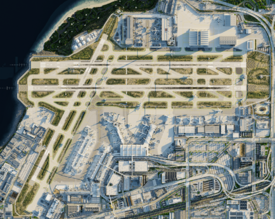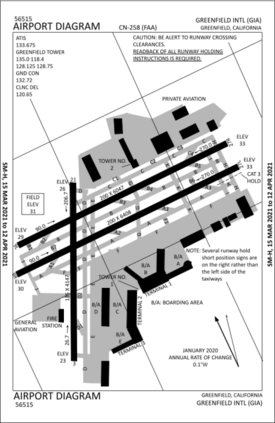Greenfield International Airport
Greenfield International Airport (IATA: GIA, ICAO: KGIA, FAA LID: GIA), typically referred to as Greenfield Airport, is an international airport located on the northeast side of Greenfield, California. Operated by the Greenfield Department of Aviation, and covering over 4 kilometers of land, GIA has non-stop flights to over 200 destinations in North America, South America, Europe, Africa, Asia, and Oceania as of 2022.
Greenfield International Airport | |||||||||||||||||||
|---|---|---|---|---|---|---|---|---|---|---|---|---|---|---|---|---|---|---|---|
 | |||||||||||||||||||
 Aerial shot of Greenfield International Airport | |||||||||||||||||||
| |||||||||||||||||||
| Summary | |||||||||||||||||||
| Airport type | Public | ||||||||||||||||||
| Serves | Greenfield Metropolitan Area | ||||||||||||||||||
| Location | Lannex, Greenfield, U.S. | ||||||||||||||||||
| Opened | 0.5.4 | ||||||||||||||||||
| Hub for | |||||||||||||||||||
| Focus city for | |||||||||||||||||||
| Elevation | 31 ft / 9 m | ||||||||||||||||||
| Coordinates | 3600, -1900 | ||||||||||||||||||
| Map | |||||||||||||||||||
 GIA Airport Diagram | |||||||||||||||||||
| Runways | |||||||||||||||||||
| |||||||||||||||||||
GIA began as an airfield for manufacturing C-54 military transports during World War II. As one of the first airports developed after the war, GIA's innovative design pioneered concepts such as concourses, direct highway access to the terminal, jet bridges, and underground refueling systems. GIA became famous during the jet age, holding he distinction as one of the world's top fifty busiest airports from 1963 to 1998, reaching 21st place for the years of 1992-1998. Today it is the world's twenty-third-busiest airport, serving 22.1 million passengers in 2022. In 2019, GIA had 268,656 aircraft movements, averaging over 700 per day.
GIA also serves as the primary western hub for Skyliners Airlines, and is the companies second largest hub. GIA also holds the distinction of being the only west coast connection for multiple international connections like Hong Kong airways and Changi Airlines
Establishment
Starting in 1923,, the California National Guard used the present airport site (known then as the Lannex lowlands) as a training airfield. The site was then dedicated as the "Greenfield Municipal Airport" by then Mayor in 1926, but it had no proper terminal building until 1939, many airlines choosing to utilize Los Angeles or San Diego instead. Once Greenfield's terminal as completed, multiple airlines including Skyliners and Unified began service here.
In 1946 and 1951 the airport had runways 3, 9, 21, and 27. In 1957 a parrallel runway was constructed along runway 9-27 renaming both to 9R-L and 27R-L.
On August 17th, 1942 the airports weather station became the official point for Greenfield weather observations and records by the National Weather Service.
World War II use
During World War IOI the United States Navy used the airport as a training facility as well as a construction site for the manufacturing of the C-54 military transports. A major defense contractor and contributor to World War II transport production, C54 Aircrafts, later known as Derksair, had their headquarters on the border of the Municipal field, and built many of their military aircraft their. Derksair used the airport for test and delivery flights from 1935 to 1952 when their main facility burned to the ground.
Because of its location next to the Pacific ocean, it was believed that the airport could be a target for Japanese retaliation especially after Pearl Harbor. Special care was taken to protect the construction facilities including building a fake neighborhood on the roof of the warehouse. This town known as Little Lannex was made of wood and fabric and hid the massive construction hangar from the sky. However Greenfield never saw any combat during the war, and in a cruel turn of fate the supplies on the roof are believed to have caused the fire that burned down the facility and caused Derksair to go out of business at the end of the war. The vacant space left by the hangar was used in later years to develop jet age terminals.
Passenger service and growth
Greenfield Municipal became Greenfield International in 1946, when Air Pocheon began direct flights to Korea. The original terminal 1 did nto have jet bridges and thus many felt a new terminal was needed to bring Greenfield into the jet age. A new terminal opened in 1955 which is currently the oldest existed terminal at the airport now called Terminal 3.
Terminal 1 and 3 modernization was completed in 1971, Terminal 2 opened in 1974 while the concourse opened in 1977. The $500 million expansion was one of the largest single building projects ever taken on by the city. In 2015 the airport finished construction on their brand new international terminal at the location of the old terminal 1. Many preservationist where angry at the destruction of the historic terminal building, but their was realistically no way the facility could have been outfitted for the modern needs of passengers and airlines. The new terminal 1 serves as the international terminal and holds the US customs. During this time a baggage system modernization occurred across the entire airport.
In the 1980s GIA hosted hubs for Skyliners and Vision Airlines. The Airline Deregulation Act of 1978 allowed regional carrier Altis (later renamed Speedfly Airlines) to create a small hub at GIA. Skyliners became the dominant carrier at GIA in the 1980s and 1990s and shifted most of its operations from LAX to GIA in 2002. As of 2015, GIA was Skyliners second largest hub overall.
In 1997 the California Department of Transportation and several U.S. federal government agencies selected a route to connect the three terminals to the nearby expressway. Nearby stakeholders especially local hotel owners objected to the proposed routing, saying it would take all the traffic off the local roads and loose business. Most notably two large hotels, the Botanist, and the Wheaton had to be demolished for the highway connection.
In 2022 the new multimodal facility was completed. This facility includes thousands of parking spaces to serve 10+ rental car services in an effort to centralize all of the services. The airport people mover was also extended to the facility, which sat next to the Lannex regional rail station, meaning passengers could now travel directly from the regional rail station to the airport.
Future
Like many airports across the nation, the aging terminal 2/3 are causing delays. Current plans involve the continued modernization of the baggage systems which started in 2012. A new terminal end is being built at the end of terminal 3, expanding the amount of gates to the terminal by 4. Minor updates to the facility will occur along side the construction.
Build History
0.5.3
Initial admin planning began at the end of 0.5.3.
0.5.4
The development of the Greenfield International Airport officially started in mid 2019, with the release of the plans for Los Llanos and Rockwell to the admin team by THEJESTR11. The original airport plan was nothing more then three parallel runways and a bunch of open grass space. Admin 56515 took the lead on developing a more detailed plan for the airport and eventually ended on a 2 parallel runway configuration with a crossing angled runway. from the very beginning the goal of the structure was to create an airport that didn't conform to Minecraft's grid. This meant that terminals would be at realistic angles from each other. Much of the early planning and laying out work was done by 56515. The road systems as well as the runway work was primarily done by Admins Staples and NJDaeger. Of the three terminals, it was decided that 56515 would tackle terminal 1, Staples terminal 2, and past Admin JacobKazias terminal 3. As the project developed many others assisted in the build process, especially with the interiors of terminals and the development of the cargo center. Eventually Architect Dasky joined the build team and quickly made some important changes to the airport to make it more realistic and in line with real life airports because of his real life experience. Together, with the help of the rest of the build team, Greenfield International Airport has become one of the most impressive parts of the project.
Facilities
Terminals
Greenfield International Airport has three public terminals named Terminal 1, 2 and 3. Terminal 2 and 3 hold the majority of domestic flights and are older, being built in the 1970s and 1980s. Terminal 1 was rebuilt in 2015, replacing the majority of the terminal, keeping one terminal leg of the original 1970s building. All international flights and some domestic flights depart from Terminal 1.
Runways
Info on the 3 runways.
Hotel
Info on the central hotel.
Ground transportation
Greenfield International Airport has extensive ground transportation options including a direct connection to the city subway system, the Rockwell/Lannex LRT, the Lannex rail station, direct highway connection, and a bus terminal.
Cargo facilities
Info on the cargo facilities.
Other facilities
Info on other facilities.
Airlines and Destinations
Passenger
Insert table about airlines and destinations here.
Cargo
Insert table about airlines and cargo destinations here.
Ground handling companies
There are four ground handling companies operating at Greenfield International Airport providing passenger, baggage, cargo and ramp services to airlines. They are:
- Greenfield Aviation Services
- Globe Handling
- Sun Ground Services (SGS)
- Novia Ground Solutions
American cargo handling company US Across also operates ramp services and a cargo facility at the airport.
Statistics
Top destinations
Insert table on top destinations of the airport. Domestic and international.
Gallery
test